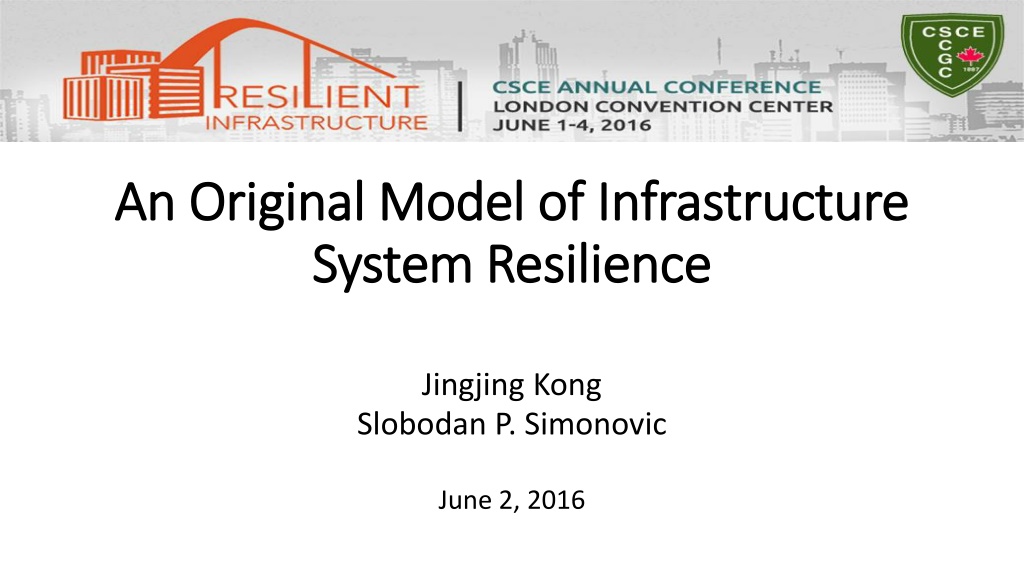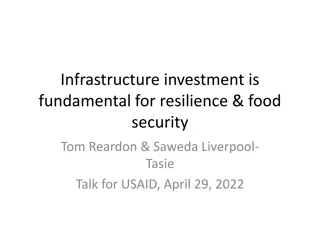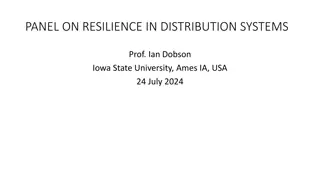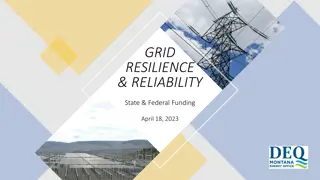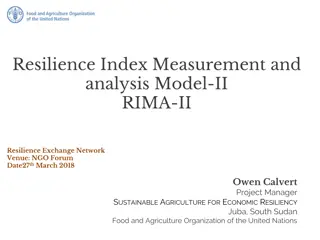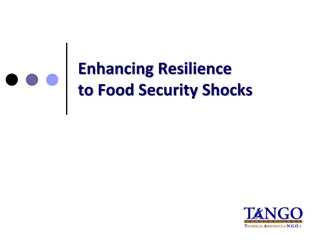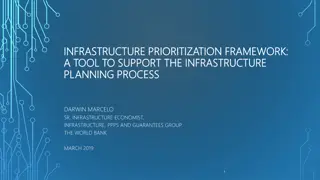Understanding Infrastructure System Resilience: A Model Approach
This document presents an original model of infrastructure system resilience by exploring interdependent networks, cascading failures, and recovery strategies. It discusses formalization, basic dependence patterns, and interdependence of multiple networks for assessing infrastructure resilience. The content emphasizes the complexity and challenges in quantifying and enhancing infrastructure system resilience.
Download Presentation

Please find below an Image/Link to download the presentation.
The content on the website is provided AS IS for your information and personal use only. It may not be sold, licensed, or shared on other websites without obtaining consent from the author. Download presentation by click this link. If you encounter any issues during the download, it is possible that the publisher has removed the file from their server.
E N D
Presentation Transcript
An An Original Model of Infrastructure Original Model of Infrastructure System Resilience System Resilience Jingjing Kong Slobodan P. Simonovic June 2, 2016
Contents Contents Introduction Infrastructure Network Formalization Infrastructure System Resilience Simulation Framework
Infrastructure system response Infrastructure system response Interdependent networks Cascading failures throughout the whole infrastructure system at regional and national scales. Effective protection and recovery strategies are hard to make. Infrastructure system resilience is often overestimated. Most researches use system robustness or system recovery rapidity of individual infrastructure system as resilience quantification metrics. Figure. Interdependence of different infrastructure (Rinaldi et al., 2001)
Infrastructure System Model Infrastructure System Model Network of networks Information network /multilayer network Nodes of the infrastructure , Power grid networks have three ( , , ) x y coordinates Water supply network Edges Intra-network links Street network y Inter-networks links x
Basic Infrastructure Dependence Patterns Basic Infrastructure Dependence Patterns Node Node dependence ( ) nn ID jn in State of node is dependent on the state of node 2 1 Node Edge dependence ( ) State of node is dependent on the state of edge ne ID ln ije 1 2 Node/Edge Path dependence ( / ) np np ID ID p ln lk e State of node or edge is dependent on State of path 2 1 1 im ne Node/Edge cluster dependence ( / ) ic nc ID ID lk e ln 2 1 State of cluster is dependent on State of node or edge 1 Geographic Dependence ( ) GL ID State of all infrastructure elements located at the same location A are affected by a disturbance simultaneously
Infrastructure Interdependence Formalization Infrastructure Interdependence Formalization Interdependence of two individual networks Four dependence: First order impacts Combination of first order impacts Interdependence of three or more individual networks Diverse combinations of two individual networks dependences Higher-order impacts: Chain and cycle reactions
Infrastructure Infrastructure System Dynamics Mechanism System Dynamics Mechanism 2 Figure. Adaptive capacity of an infrastructure after a disturbance T Buffer time B T Malfunction time M T Repair time R Figure. Dynamic process of an infrastructure after a disturbance
Definition of infrastructure system resilience Definition of infrastructure system resilience Based on the definition by Bruneau et al (2003) , Simonovic et al (2013), Presidential Policy Directive 21 and other sources focusing on engineering resilience of networked infrastructures. Infrastructure system resilience is the systems ability to resist (prevent and withstand) possible hazards, absorb the initial damage from hazard, and recover to normal operation levels. Reactive absorptive capacity AND Proactive restorative capacity Robustness, Redundancy, Resourcefulness, Rapidity
Infrastructure system performance Infrastructure system performance Resourcefulness: the capacity to identify problems, establish priorities, and mobilize resources when conditions exist that threaten to disrupt some elements, or a system. = , , , ( ) t ( ) t ( ) t R SP SP 1 1 1 Re 0 1), s Robustness: the ability of a systems to withstand a given level of stress without suffering degradation or loss of function. ( ) = , , , ( ( 1) ( ) t f SP t RS t SP 1 1 1 0 Res = ( ) t ( ) ( ) t R SP t SP 1 1 1 0 ( ) = , , ( 1), ( 1) ( ) t F SP t RS t SP 1 1 1 0 o o + + * * ( ) N ( ) E n t e t Rob = , * ( ) t R Rapidity : the capacity to meet priorities and achieve goals in a timely manner in order to contain losses and avoid future disruption. 1 + * * ( ( ) ( )) n t e t o o = ( ) R t 1 Rob + ( ) N E 1 after = = , , ( 1) R t R t 1 1 1 Rap Rob O = , R t t 1 2 1 Rap O O Typical Performance Process of Infrastructure System = , max R R 1 1 Rap Rap
Infrastructure system resilience Infrastructure system resilience RA PR = + ( ) t ( ) t ( ) t r r RA PR = + , , , ( ) t ( ) t ( ) t 1 1 1 1 1 1 t , ( ) t dt SP 1 0 t = , ( ) t 1 O 1 RA 1 t t , ( ) t dt R 1 Res t t = , ( ) t 1 O , ( ) t dt SP 1 1 PR 1 t 0 t = , ( ) t 1 O 1 RA 1 t t ( ) t dt R 1 Res t = ( ) t 1 O 1 PR 1 t Typical Performance Process of Infrastructure System
Simulation Framework Simulation Framework Multilayer Infrastructure Network Model y x Infrastructure System Dynamic Mechanism interdependence TB, TR, TM Restorative Strategy Single Layer Infrastructure System Performance Multilayer Infrastructure System Resilience Disaster Scenario (removal of network elements )
RESILIENT INFRASTRUCTURE June 1 4, 2016 Thank you! Thank you! Jingjing Kong kjingjin@uwo.ca
